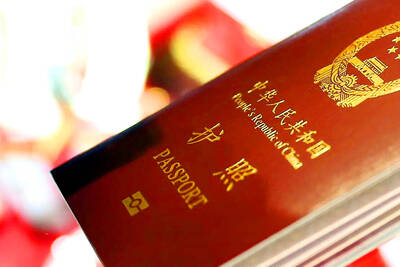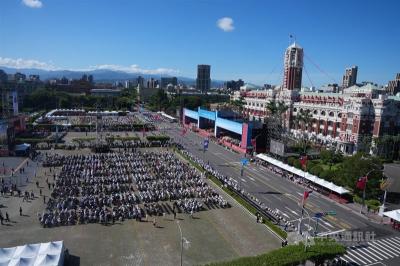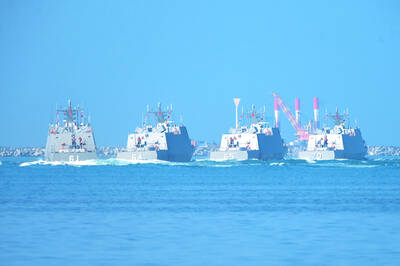Premier Frank Hsieh (
"The government is under a lot of pressure for injecting more money into the project, but it's worth it," Hsieh told reporters after the 15-minute ride. "It would be regrettable to give up on it now."
The train departed from Tainan Station, headed northward to Tainan County's Liouchia (六甲) Township and then south to Dashe (大社) Township in Kaohsiung County before returning to the station.
The Taiwan High-Speed Rail Corp (THSRC), builder of the high-speed rail system, reached its target of running the bullet train at a top speed of 315kph on Oct. 30.
THSRC chairwoman Nita Ing (
"This is a milestone for us," Ing said, adding that her first experience on the train was very good.
Ing said that THSRC will hold a provisional board meeting next week and a shareholder meeting in January -- instead of May -- to discuss the approval of three new board directors representing the government, as required by the Ministry of Transportation and Communications.
THSRC expanded the number of its board directors from 12 to 15 seats last month after the government decided to pump another NT$7.5 billion (US$223 million) into the project. That amount included NT$4.5 billion from the China Aviation Development Foundation and NT$3 billion from China Technical Consultant Inc.
The government currently has two seats in the board but hopes to obtain three more. However, whether the government will be able to occupy the three new seats remains to be negotiated, said Arthur Chiang (江金山), vice president of THSRC's administration division.
The government's holding in THSRC jumped from 11.89 percent to about 37 percent, but 19 percent of that was through purchasing preferred shares, which confer no voting rights, Chiang said.
Ing declined to reveal how much capital the company still needs to complete the project's construction, saying a new fund-raising plan will be released by the middle of the month.
The one-year delay of the project is estimated to cost the company an additional NT$19.3 billion, Chiang said.
Ing announced on Sept. 8 that the firm's board of directors decided to reschedule the opening of the high-speed railway to Oct. 31 next year, blaming delays in the construction of the core mechanical and electrical systems.
THSRC is currently negotiating compensation for the delays with the Taiwan Shinkansen Corp (TSC, 台灣新幹線), contractor for the core system's construction. Yesterday, TSC chairman Takaomi Goto said he hopes the negotiation will be completed by the end of the month.
"I think who should bear the responsibility for the delay is still an open question," Goto told the Taipei Times yesterday.
Becoming familiar with the Japanese-designed bullet train system has taken a lot of time, especially for the THSRC, whose engineers are mostly US and European, Goto said.
Despite the setback in exporting the system for the first time, from a business point of view, the Japanese consortium will still look for other countries in which to introduce the bullet train, Goto added.
The consortium of seven Japanese companies includes Mitsui Corp, Mitsubishi Heavy Industries, Mitsubishi Corp, Marubeni Corp, Sumitomo Corp, Kawasaki Heavy Industries and Toshiba Electric.
As of the end of September, THSRC said it had completed 89.7 percent of the project, according to a company release. The core mechanical and electrical system which THSRC is responsible for is 66 percent completed, while the project's track and station construction are 83 percent and 93.1 percent finished, the release added.
The Tainan station yesterday seemed far from ready to serve customers, with many areas still blocked off.
THSRC plans to test the track in Taoyuan and other areas in the north starting in January, Ing said.

The Ministry of the Interior (MOI) is to tighten rules for candidates running for public office, requiring them to declare that they do not hold a Chinese household registration or passport, and that they possess no other foreign citizenship. The requirement was set out in a draft amendment to the Enforcement Rules of the Public Officials Election and Recall Act (公職人員選舉罷免法 ) released by the ministry on Thursday. Under the proposal, candidates would need to make the declaration when submitting their registration forms, which would be published in the official election bulletin. The move follows the removal of several elected officials who were

The Republic of China (ROC) is celebrating its 114th Double Ten National Day today, featuring military parades and a variety of performances and speeches in front of the Presidential Office in Taipei. The Taiwan Taiko Association opened the celebrations with a 100-drummer performance, including young percussionists. As per tradition, an air force Mirage 2000 fighter jet flew over the Presidential Office as a part of the performance. The Honor Guards of the ROC and its marching band also heralded in a military parade. Students from Taichung's Shin Min High School then followed with a colorful performance using floral imagery to represent Taiwan's alternate name

FOUR DESIGNATED AREAS: Notices were issued for live-fire exercises in waters south and northwest of Penghu, northeast of Keelung and west of Kaohsiung, they said The military is planning three major annual exercises across the army, navy and air force this month, with the navy’s “Hai Chiang” (海強, “Sea Strong”) drills running from today through Thursday, the Ministry of National Defense said yesterday. The Hai Chiang exercise, which is to take place in waters surrounding Taiwan, would feature P-3C Orion maritime patrol aircraft and S-70C anti-submarine helicopters, the ministry said, adding that the drills aim to bolster the nation’s offshore defensive capabilities. China has intensified military and psychological pressure against Taiwan, repeatedly sending warplanes and vessels into areas near the nation’s air defense identification zone and across

A Chinese takeover of Taiwan would severely threaten the national security of the US, Japan, the Philippines and other nations, while global economic losses could reach US$10 trillion, National Security Council Deputy Secretary-General Lin Fei-fan (林飛帆) wrote in an article published yesterday in Foreign Affairs. “The future of Taiwan is not merely a regional concern; it is a test of whether the international order can withstand the pressure of authoritarian expansionism,” Lin wrote in the article titled “Taiwan’s Plan for Peace Through Strength — How Investments in Resilience Can Deter Beijing.” Chinese President Xi Jinping’s (習近平) intent to take Taiwan by force